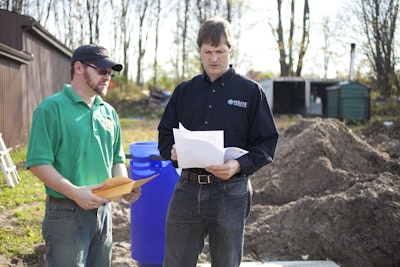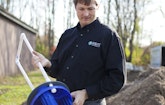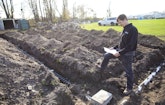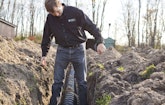
Interested in Repair?
Get Repair articles, news and videos right in your inbox! Sign up now.
Repair + Get AlertsIt's a gift to experience firsthand how wastewater treatment can help a body of water. Eric Murdock received that gift in his pre-teen years.
In 1980, when Murdock was 10 years old, his family moved to a home on Goodyear Lake near Cooperstown, N.Y., at the headwaters on the Susquehanna River. Back then, there were direct sewer discharges into the river upstream of the 3-mile-long lake.
"There were floatables in the lake," recalls Murdock, now owner of Onsite Engineering in Syracuse. "You didn't want to go swimming. It was a nuisance. It was an eyesore. But in the first couple of years we lived there, a political movement was underway to eliminate those discharges.
"As a result, as a very young person, I got to witness the benefits of protecting the environment. The lake water turned over fairly quickly, and within a few years, the water quality was vastly improved. That was an early influence that got me thinking that I wanted to pursue environmental sciences as a career."
Today, Murdock protects lakes in the Syracuse area and elsewhere in his state by designing onsite treatment solutions for severely challenging waterfront properties. He collaborates with other engineers on system designs, sells advanced treatment units, supervises installations, and handles ongoing system operations and maintenance.
In the bigger picture, he helps small communities evaluate onsite solutions as cost-effective alternatives to big-pipe centralized sewer systems.
Turn toward onsite
Murdock earned an engineering degree in environmental resource management in 1993 from the College of Environmental Science and Forestry at State University of New York in Syracuse. After college, he worked for a utility company's hydroelectric department on renewable energy projects, for an engineering firm doing work around removing sources of clear water from municipal sewer systems, and for one of the world's largest engineering firms supporting environmental projects.
He made a change in direction in 2002, joining the U.S. Environmental Protection Agency as project manager for the Skaneateles Lake Demonstration Project, which tested a variety of advanced onsite treatment systems on properties around the 13.6-square-mile, 16-mile-long Finger Lake that is the unfiltered source of drinking water for the City of Syracuse.
During seven years in that capacity, he formed a technical committee of state and county health department officials that researched alternative onsite treatment technologies and ultimately deployed 19 different systems on Skaneateles Lake lots – properties unsuited for conventional septic systems for lack of space, impermeable soils, and high bedrock or groundwater.
"We had a budget to attend conferences and seminars," Murdock recalls. "The whole focus of our job was to research and bring together, in one location, what we believed were the technologies best suited to solve the problems of challenging lakefront properties. As the lead on the project, I was able to select the equipment we would showcase.
"We emphasized working with manufacturers that had established track records, that were interested in setting up distribution networks, that had design programs for engineers – basically companies that seemed committed to the long term. One big point of emphasis was that we did not put in mound systems. We were trying to prove the science of treating wastewater and distributing treated water into the soil. We wanted to break it down and put in only the size systems that were actually needed."
As effluent sampling and analysis consistently documented that the treatment units worked, regulators grew comfortable with the technologies. The result is that advanced treatment units are required at sites that cannot meet new-construction standards.
Spreading the word
The demonstration project also included training sessions for educators, health department regulators and engineers, all in cooperation with the nonprofit New York State Onsite Training Network (OTN). Training included classroom study and hands-on instruction on systems in the field.
Murdock continues to host that training under the banner of Onsite Engineering with coordination by the OTN and participation from leading treatment system manufacturers. Meanwhile, the state health department and the DEC have invited Murdock to review and comment on updates to onsite treatment regulations and guidance documents. "The project also gave me a unique opportunity to meet the founders and leaders of the most respected companies in onsite wastewater," Murdock adds.
The demonstration project led directly to the kind of work that is now a stock-in-trade of Onsite Engineering, founded in 2007. "After I started doing the training, regulators began calling me for help with sites that looked completely impossible," Murdock recalls. "On probably the first two dozen jobs I did, I was the second or third engineer who had taken on the project. I've been the fourth engineer on at least half a dozen jobs and the third engineer on dozens of jobs.
"Many of these were jobs that very competent engineers with track records longer than mine had looked at. They were like the square peg in the round hole – the jobs didn't fit anything they had done before. With my expertise from the Skaneateles project, they were a natural fit. Jobs otherwise seen as impossible, for me were just another job."
One such project involved a lot where essentially the entire space was occupied by the house and an unpaved driveway, and the former treatment system was a dry well two feet from the lake. The solution: Put the drainfield under the driveway. In that case, the biggest challenge was getting regulators' approval for something that hadn't been tried.
"I do the same basic scenario every time," says Murdock. "Pretreat the effluent, use time dosing, move the dispersal field as far away from the lake as possible, and spread it out over the largest possible surface area. It has worked very well. Sometimes the driveway is the farthest location away from the water, and it's the only space available. If you design it so the piping can handle the traffic load, and if you pretreat the water so there isn't going to be a biomat in the trenches, it's a workable solution."
Some of Murdock's designs include both an aerobic treatment unit and a tertiary sand filter. For drainfields within 100 feet of a lake, he prefers to use disinfection – generally with a Salcor UV light system. In the past few years, Murdock has been involved in a variety of ways with about 60 systems per year.
Equipment business
As Murdock's reputation grew, he began getting inquiries from other engineers. "I had trained many engineers, but there was still a learning curve with the advanced onsite systems," Murdock says. "Some engineers found it easier to pass referrals to me to take the job altogether. Then they could shadow me and watch how I did it, so the next time they could use the same techniques on their own."
It soon became clear that a natural step was to become an equipment distributor. Murdock had specified and sold about a dozen types of treatment units and had experience as a manufacturer-trained installer and service provider. So in 2009, he started a new business, Onsite Sales and Service. The company serves as master agent in New York for Clarus Environmental and its Fusion series aerobic treatment units.
"I'm a big fan of the Fusion," says Murdock. "The fact that there are 9 million of these systems in Japan exemplifies that they are very efficient. They work very well, and we've had tremendous success with them." Besides Fusion systems for single-family homes, he offers Clarus recirculating gravel filters in capacities up to 25,000 gpd.
As an equipment supplier, he also supervises installations on behalf of engineers. "The design engineers can simply finish their drawings, submit them to the health department, get approval, and have Onsite Engineering do the construction observation," Murdock says. "Onsite Sales and Service then does the startup and the long-term maintenance.
"So the design engineer avoids holding the liability for construction observation. I've found that engineers are happy to be relieved of that. They're also more willing to try a system with which they have no experience, knowing that somebody who has that experience is going to supervise and sign off on it. I'm trying not to compete with engineers but rather help them. The way to build business volume is by working with a lot of engineers."
The Onsite Engineering team includes a mapping and computer-aided design (CAD) specialist and Bob Eichinger, who has varied responsibilities. Eichinger is located in the Hudson River Valley, four hours from the home office, giving the company access to another large geographic market. "Bob has lived extensively on Long Island and in the Hudson Valley," says Murdock. "He has been involved in many aspects of the onsite world, and that includes owning an installation company. His main function is to serve as an advisor to municipal and commercial clients."
Keeping it simple
While the sites Murdock deals with require engineering solutions, he is not a fan of overly complex designs – he prefers to keep them as simple as possible: "Why spec out a system that's very elaborate when the very simple system that was in the ground appears to have worked well for many years?" he asks.
His systems typically involve pressure distribution, or pump-assisted distribution where septic tank effluent is lifted to a distribution box and flows by gravity from there. He's a believer in the septic tank effluent pump (STEP) vault (Clarus Environmental), both for individual onsite systems and for communities seeking alternatives to the big pipe.
"A lot of small communities on septic systems are hearing the big-pipe engineers say, 'You're going to need a central collection and treatment system,' " Murdock says. "The middle-of-the-road solution is to convert the existing system. That means using the septic tanks for primary settling at the house, retrofitting STEP vaults, and then pumping the septic tank effluent to a common treatment and dispersal field. I think that's going to be a much more common scenario into the future.
"In recent years, I have focused on bridging the gap between the big engineering companies that have a long history of using the big pipe, and communities that are under financial distress and have concluded that they can't afford the big pipe. I want to introduce alternative wastewater treatment systems, including STEP systems, and other approaches using different collection, treatment and dispersal options in an onsite setting.
"A lot of communities in New York State are faced with the problem of aging infrastructure," he continues. "They need to keep taxes down, yet still expand and grow. We've actually been hired by the state Cooperative Extension to prepare an analysis of half a dozen different communities, comparing the big-pipe approach to an onsite approach.
"Half of those communities have selected the big pipe, despite the efforts of Onsite Engineering to educate them on what their decentralized options are. It appears as though the big engineering firms will continue to do what they always do, and that's the big pipe. They're experts at that, and it's very hard for a small company to compete with a big-pipe engineer.
"In this next phase of the game, we'll be trying to bridge the gap between the big engineering companies and the small communities' needs. That is, providing the technical expertise to help the big engineering companies design the onsite solution.
"That's really what our focus is going forward."












